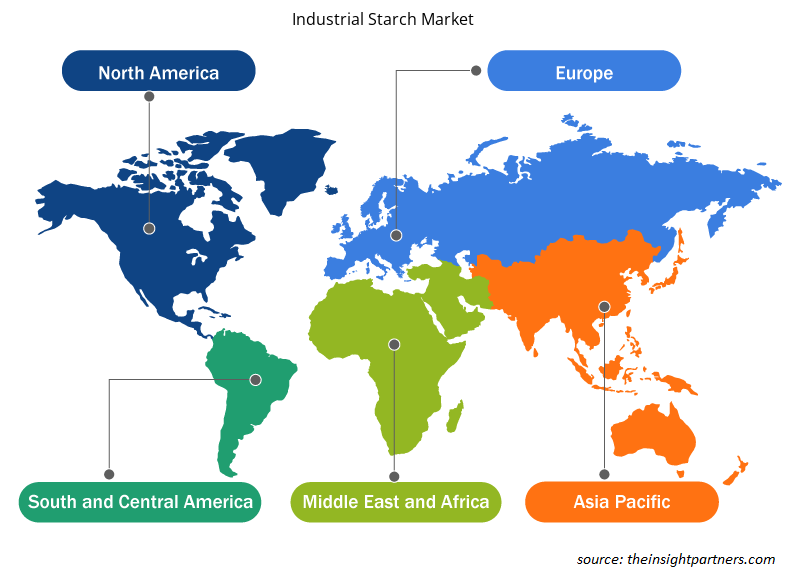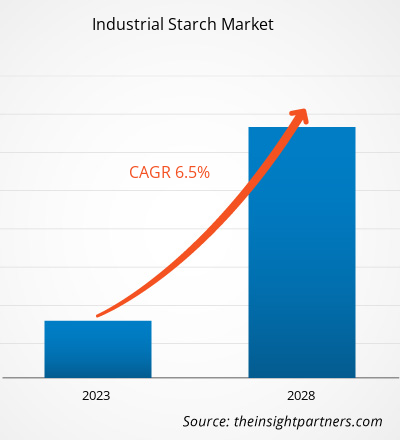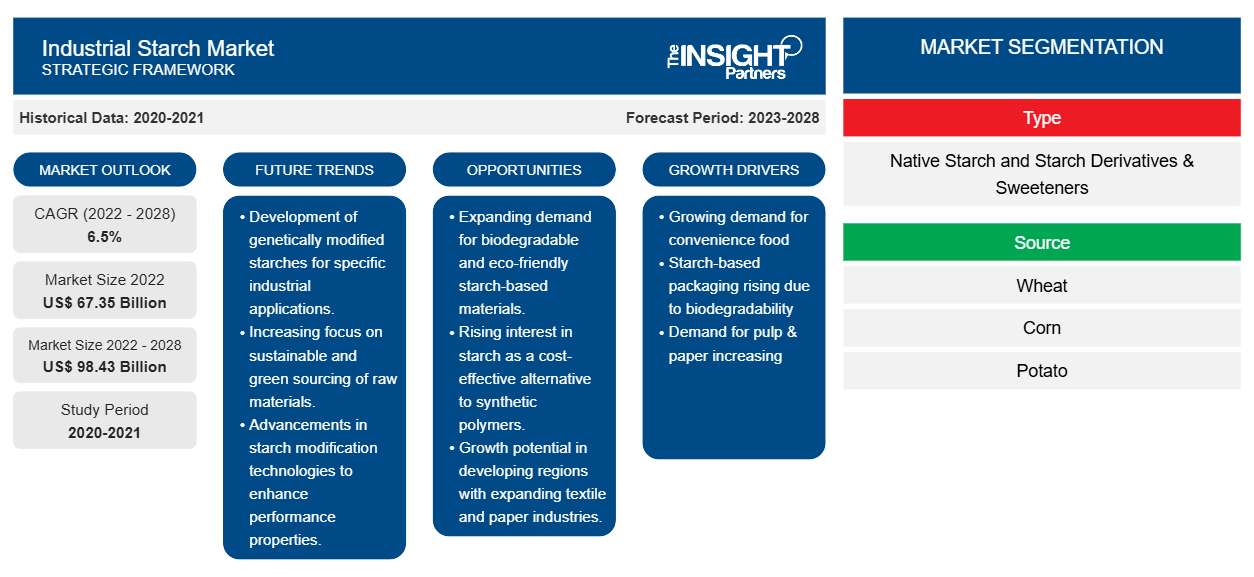[Rapporto di ricerca] Si prevede che il mercato dell'amido industriale crescerà da 67.353,01 milioni di dollari nel 2022 a 98.426,74 milioni di dollari entro il 2028; si stima che crescerà a un CAGR del 6,5% dal 2022 al 2028.
L'amido è un carboidrato complesso derivato da grano, mais, patate, tapioca e riso. È un'ottima fonte di energia. L'amido è un agente addensante/gelificante e stabilizzante in un'ampia gamma di alimenti e bevande, tra cui prodotti da forno e dolciari, zuppe, salse, dessert surgelati, creme di latte e bevande pronte da bere. La domanda di cibi pronti sta aumentando a livello globale a causa dello stile di vita frenetico dei consumatori e dell'elevato reddito pro capite. Inoltre, gli imballaggi alimentari a base di carta necessitano di un rivestimento per impedire all'acqua o all'ossigeno di penetrare nell'imballaggio e rovinare il prodotto alimentare all'interno. Di solito, questo rivestimento protettivo è prodotto da plastica a base di petrolio. Tuttavia, i produttori stanno adottando materie prime biologiche ed ecologiche per il rivestimento degli imballaggi alimentari a base di carta con una crescente consapevolezza dell'impatto negativo della plastica a base di petrolio sull'ambiente. Le caratteristiche degli imballaggi a base di amido come la biodegradabilità e l'accessibilità stanno spingendo la popolarità tra i produttori.
Negli ultimi anni, la domanda di amido nell'industria della carta e della cellulosa è cresciuta in modo significativo con le operazioni su larga scala in questo settore. Il fiorente settore dell'e-commerce contribuisce in modo significativo alla domanda di cartoni ondulati. Inoltre, un notevole spostamento verso imballaggi privi di plastica per garantire la sostenibilità ambientale sta spingendo la domanda di materiali di imballaggio sostenibili. Secondo una ricerca condotta da Roquette Frères, il consumo di amido industriale nella produzione di cartone ondulato è aumentato del 6% nel 2020 a causa del significativo aumento del settore dell'e-commerce durante la pandemia di COVID-19. Pertanto, la crescente domanda di amido nell'industria della carta e del cartone sta rafforzando il mercato dell'amido industriale
Personalizza questo report in base alle tue esigenze
Riceverai la personalizzazione gratuita di qualsiasi report, comprese parti di questo report, o analisi a livello nazionale, pacchetto dati Excel, oltre a usufruire di grandi offerte e sconti per start-up e università
- Scopri le principali tendenze di mercato in questo rapporto.Questo campione GRATUITO includerà analisi di dati che spaziano dalle tendenze di mercato alle stime e alle previsioni.
I produttori di tutto il mondo stanno beneficiando della crescita del settore dell'e-commerce. In tutto il mondo, vari produttori e canali di e-commerce stanno promuovendo l'uso di materiali di imballaggio sostenibili ed ecocompatibili. Si prevede che la crescita del mercato dell'amido industriale aumenterà con questa crescente adozione di materiali di imballaggio sostenibili da parte del settore dell'e-commerce. Le società indiane di e-commerce Myntra e Flipkart hanno adottato misure per ridurre o eliminare l'uso di plastica monouso nei loro materiali di imballaggio. Inoltre, si prevede che le politiche governative per ridurre l'inquinamento da plastica aumenteranno la domanda di amido industriale.benefitting from the growth of the e-commerce industry. Across the globe, various manufacturers and e-commerce channels are promoting the use of sustainable and eco-friendly packaging materials. The industrial starch market growth is expected to boost with this increasing adoption of Myntra and Flipkart have adopted to reduce or eliminate the use of single-use plastic in their packaging materials. Moreover, government policies to reduce plastic pollution is expected to boost the demand for industrial starch.
Approfondimenti di mercato
Ampio campo di applicazione dell'amido industriale alimenta la crescita del mercato
La gamma di applicazioni degli amidi industriali in vari settori di utilizzo finale si è ampliata negli ultimi anni. Viene utilizzato come agente addensante, gelificante e legante in un'ampia gamma di alimenti e bevande, tra cui prodotti da forno, zuppe e condimenti per insalate, dolciumi, salse, gelati , bevande alla frutta e latticini. L'amido viene utilizzato anche in applicazioni non alimentari come cellulosa e carta, prodotti farmaceutici e mangimi per animali. Nell'industria farmaceutica, l'amido viene utilizzato come eccipiente e legante nella produzione di compresse. Inoltre, i materiali a base di amido sono una soluzione perfetta per materiali di imballaggio alimentare biodegradabili che aiutano a ridurre l'inquinamento ambientale.excipient and binding agent in tablet making. Moreover, starch-based materials are a perfect solution for biodegradable food packaging materials that help to reduce environmental pollution.
Tipo Informazioni
In base al tipo, il mercato dell'amido industriale è segmentato in amido nativo e derivati dell'amido e dolcificanti. Nel 2021, il segmento dei derivati dell'amido e dei dolcificanti ha dominato il mercato. La crescente domanda di alimenti e bevande, dovuta all'aumento dei livelli di reddito disponibile e all'aumento della popolazione globale, e l'uso di derivati dell'amido nell'industria alimentare e delle bevande rappresentano il motore di crescita più importante per il segmento dei derivati dell'amido del mercato dell'amido industriale.
Agrana Beteiligungs-AG; ADM; Ingredion Incorporated; Roquette Frères; Tereos Group; Cargill, Incorporated; Tate & Lyle PLC; Grain Processing Corporation; Royal Cosun; e AVEBE sono tra i principali attori che operano nel mercato dell'amido industriale. I principali attori adottano diverse strategie, come fusioni e acquisizioni e lanci di prodotti, per espandere la loro presenza geografica e la base di consumatori. Beteiligungs-AG; ADM; Ingredion Incorporated; Roquette Frères; Tereos Group; Cargill, Incorporated; Tate & Lyle PLC; Grain Processing Corporation; Royal Cosun; and AVEBE are among the key players operating in the industrial starch market. The leading players adopt several strategies, such as mergers & acquisitions and product launches, to expand their geographic presence and consumer base.
Segnala i riflettori
- Tendenze progressive nel settore dell'amido industriale per aiutare gli operatori a sviluppare strategie efficaci a lungo termine
- Strategie di crescita aziendale adottate dalle aziende per garantire la crescita nei mercati sviluppati e in via di sviluppo
- Analisi quantitativa del mercato globale dell'amido industriale dal 2021 al 2028
- Stima della domanda di amido industriale nei vari settori
- Analisi delle cinque forze di Porter per illustrare l'efficacia degli acquirenti e dei fornitori che operano nel settore dell'amido industriale
- Sviluppi recenti per comprendere lo scenario competitivo del mercato e la domanda di amido industriale
- Tendenze e prospettive di mercato, insieme ai fattori che regolano la crescita del mercato dell'amido industriale
- Comprensione delle strategie che sostengono l'interesse commerciale in relazione alla crescita del mercato, aiutando nel processo decisionale
- Dimensioni del mercato dell'amido industriale nei vari nodi del mercato
- Panoramica dettagliata e segmentazione del mercato nonché delle dinamiche del settore
- Dimensioni del mercato dell'amido industriale in varie regioni con promettenti opportunità di crescita
Approfondimenti regionali sul mercato dell'amido industriale
Le tendenze regionali e i fattori che influenzano il mercato dell'amido industriale durante il periodo di previsione sono stati ampiamente spiegati dagli analisti di Insight Partners. Questa sezione discute anche i segmenti e la geografia del mercato dell'amido industriale in Nord America, Europa, Asia Pacifico, Medio Oriente e Africa e America meridionale e centrale.

- Ottieni i dati specifici regionali per il mercato dell'amido industriale
Ambito del rapporto sul mercato dell'amido industriale
| Attributo del report | Dettagli |
|---|---|
| Dimensioni del mercato nel 2022 | 67,35 miliardi di dollari USA |
| Dimensioni del mercato entro il 2028 | 98,43 miliardi di dollari USA |
| CAGR globale (2022 - 2028) | 6,5% |
| Dati storici | 2020-2021 |
| Periodo di previsione | 2023-2028 |
| Segmenti coperti | Per tipo
|
| Regioni e Paesi coperti | America del Nord
|
| Leader di mercato e profili aziendali chiave |
|
Densità degli attori del mercato dell'amido industriale: comprendere il suo impatto sulle dinamiche aziendali
Il mercato dell'amido industriale sta crescendo rapidamente, spinto dalla crescente domanda degli utenti finali dovuta a fattori quali l'evoluzione delle preferenze dei consumatori, i progressi tecnologici e una maggiore consapevolezza dei benefici del prodotto. Con l'aumento della domanda, le aziende stanno ampliando le loro offerte, innovando per soddisfare le esigenze dei consumatori e capitalizzando sulle tendenze emergenti, il che alimenta ulteriormente la crescita del mercato.
La densità degli operatori di mercato si riferisce alla distribuzione di aziende o società che operano in un particolare mercato o settore. Indica quanti concorrenti (operatori di mercato) sono presenti in un dato spazio di mercato in relazione alle sue dimensioni o al valore di mercato totale.
Le principali aziende che operano nel mercato dell'amido industriale sono:
- AGRANA Beteiligungs-AG
- Direttore Generale
- Ingredion Incorporated
- Fratelli Roquette
- Gruppo Tereos
Disclaimer : le aziende elencate sopra non sono classificate secondo un ordine particolare.

- Ottieni una panoramica dei principali attori del mercato dell'amido industriale
"Industrial Starch Market Analysis to 2028" è uno studio specializzato e approfondito del settore chimico e dei materiali, incentrato sull'analisi delle tendenze di mercato. Il rapporto mira a fornire una panoramica del mercato con una segmentazione dettagliata. Il mercato dell'amido industriale è segmentato in base a tipo, fonte, applicazione e geografia. In base al tipo, il mercato dell'amido industriale è segmentato in amido nativo e derivati e dolcificanti dell'amido. In base alla fonte, il mercato è segmentato in grano, mais, patate, manioca e altri. In base all'applicazione, il mercato è segmentato in alimenti e bevande, cellulosa e carta, mangimi per animali, prodotti farmaceutici e altri. In base alla geografia, è segmentato in cinque regioni principali: Nord America, Europa, Asia Pacifico, Medio Oriente e Africa e Sud e Centro America. Nel 2021, l'Asia Pacifico ha dominato il mercato dell'amido industriale.
- Analisi storica (2 anni), anno base, previsione (7 anni) con CAGR
- Analisi PEST e SWOT
- Valore/volume delle dimensioni del mercato - Globale, Regionale, Nazionale
- Industria e panorama competitivo
- Set di dati Excel
Report recenti
Testimonianze
Motivo dell'acquisto
- Processo decisionale informato
- Comprensione delle dinamiche di mercato
- Analisi competitiva
- Analisi dei clienti
- Previsioni di mercato
- Mitigazione del rischio
- Pianificazione strategica
- Giustificazione degli investimenti
- Identificazione dei mercati emergenti
- Miglioramento delle strategie di marketing
- Aumento dell'efficienza operativa
- Allineamento alle tendenze normative





















 Ottieni un campione gratuito per - Mercato dell'amido industriale
Ottieni un campione gratuito per - Mercato dell'amido industriale